Floor noise tongue groove
Home Improvement Asked by Stcks4 on May 9, 2021
I own an old 60s kit house that has tongue and groove 6″ pine boards for the ceiling in the main floor room.
In the upstairs room above, they laid ¼ OSB as subfloor and secured it to the boards by placing random screws in the OSB.
As you guessed, I am getting a lot of noise from the joints of the tongue and groove every time you walk across it.
I’m looking for a solution to reduce that noise. I have three options so far:
- Glue the OSB to be tongue and groove boards and add screws.
- Put screws in every 6 inches on either side of the joints.
- Both
Other questions, is there anything I should do with the tongue and groove boards now that I have them exposed?
Is there a different subfloor to use? Weight?
3 Answers
Are the joist 16" oc? If not you may want to sister them for added strength, and give you a better nailng/screwing surface. The 1/4" doesn't give the best support for subflorring, so you need to upgrade to 3/4" or at least 1/2" plywood. It's also a good idea to use a glue like liquid nails or other adhesive over the joist. Your fastners should be placed about every 8 inches. Good Luck!
Answered by rsschuler on May 9, 2021
I'm guessing that any screws that hit the T&G could then be seen from the main floor room if too long - the issue with "too long" is that anything that is just long enough to not show won't do much good, and guessing this is being used for living space.
wood on wood is an issue - needs a barrier between or this will happen no matter what you do. Wood expands and contracts with temp and moisture - impossible thing to stop and over time loosens fasteners.
If the weight isn't an issue, would recommend a heavier sub-floor with some sort of barrier between the surfaces; some have used roofing felt with reasonable success but there are products specifically for this application. There are 3/4 or 1" T&G sheet goods that provide a very good base over your T&G pine. Check your local home center; they come in 4x8 sheets.
And of course, fasten to the joists and not just to the T&G pine for the connection strength.
If that isn't an option, then laying a lighter sub-floor in the opposite orientation to your current flooring. Adhesive may help, but 3/4 pine isn't much to support the weight of persons and furniture without movement. alternating will help.
For a "quick fix", try to remove the most offensive area, apply the adhesive, and attach replacement sub-floor -- BUT, remember, wood moves and a solid mechanical connection, while sounds like the answer, may not be to your best advantage, so add the barrier (and ya, that changes the height, and ha, then that ... so much for quick, right) :)
Just my 2 cents;
Answered by Borzio on May 9, 2021
The T&G is 2" x 6" x 8' pine. Because they are the ceiling of the room beneath. I can not add any new joists. Here is the conclusion I have come to. 1. Remove all the old particle board subfloor. 2. Place a bead of liquid nails in any of the T&G joints that have a gap. 3. Use new ¼ plywood 4'x8' sheets run the grain of the plywood across the 2x6 T&G pine. 4. Use Titebond II 1-gal. Premium Wood Glue. This gives me 60 minutes to set up. Cove the T&G is 2" x 6" x 8' pine then place the plywood on top. 5. Mark the joint locations on the plywood. The drive 1 1/5" deck screws every 8" on either side of the joints. (A lot of screws) 6. Place a layer of QEP 2 ft. x 3 ft. x 1/4 in. Cork Underlayment Sheet. On top of the plywood. 7. The padding and carpet. If it makes noise after all this so be it! The only other solution is to sell the house and that will not happen. Thanks for all your help.
Answered by Stcks4 on May 9, 2021
Add your own answers!
Ask a Question
Get help from others!
Recent Questions
- How can I transform graph image into a tikzpicture LaTeX code?
- How Do I Get The Ifruit App Off Of Gta 5 / Grand Theft Auto 5
- Iv’e designed a space elevator using a series of lasers. do you know anybody i could submit the designs too that could manufacture the concept and put it to use
- Need help finding a book. Female OP protagonist, magic
- Why is the WWF pending games (“Your turn”) area replaced w/ a column of “Bonus & Reward”gift boxes?
Recent Answers
- Joshua Engel on Why fry rice before boiling?
- haakon.io on Why fry rice before boiling?
- Peter Machado on Why fry rice before boiling?
- Lex on Does Google Analytics track 404 page responses as valid page views?
- Jon Church on Why fry rice before boiling?

